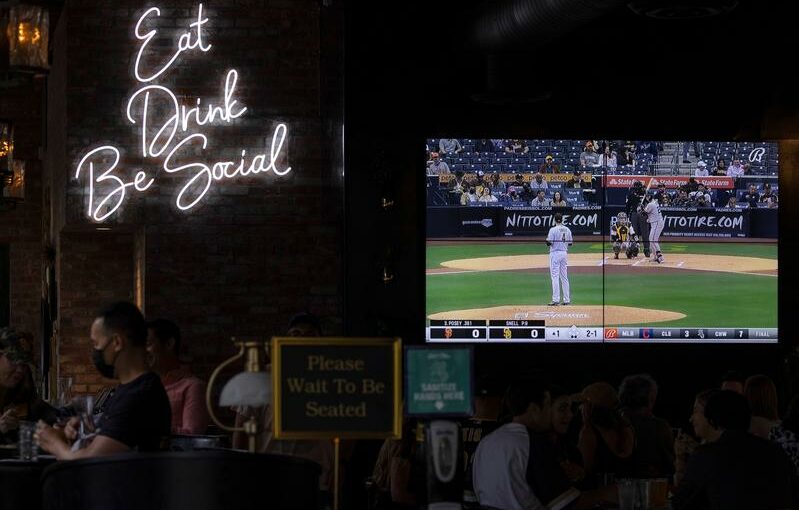SAN DIEGO (Reuters) – It was Saturday night in downtown San Diego, and J Street near the Petco Park baseball stadium was bustling.
Fans of the hometown Padres, many decked out in team gear, packed the bars and restaurants with more waiting in line and happy to do so after a year of pandemic lockdown.
“It’s definitely a feel-good time,” said lawyer Chris Schon, 33, as he waited for a table outside Bub’s at the Ballpark, a sports bar.
However festive the scene, it nonetheless highlights some of the limits emerging in the U.S. economic recovery.
The Padres have been “selling out” most every game since Major League Baseball’s reopening a month ago, but in the age of coronavirus that means hitting an attendance cap of around 15,000, or roughly a third of capacity. Elsewhere in the league, results are lagging.
The surrounding restaurants, dependent on summertime ballpark crowds, remain limited to 50% capacity in California for at least another month. Owners expect depressed revenue through 2021 and worry that even as restrictions are lifted people will hesitate to join standing-room-only crowds.
“Back in the good old days, we were four or five deep at the bar, slinging beers…. Are people going to get turned off by that?” wondered Brant Crenshaw, a partner in the Social Tap bar and restaurant where big-screen TVs and picture window views of the ballpark are a draw.
His opening day revenue this year? Around $15,000 versus $30,000 to $40,000 in prior years.
‘NOT BACK TO WHERE WE WERE’
The start of a full baseball season with 162 games on tap was a milestone in the U.S. reopening. The 2020 season, shortened to 60 games and played in empty stadiums, gave way to the fanfare of Opening Day 2021 and dreams of playoff games packed with cheering crowds come October.
Restrictions are being eased as coronavirus vaccinations proceed and daily infections and deaths ebb.
Among the largest U.S. states, Texas and Florida have dropped all COVID-related limits, New York is allowing restaurants to reopen at full capacity on May 19, and California plans to lift most remaining restrictions on June 15.
However, data including national travel statistics as well as stadium-by-stadium baseball attendance tmsnrt.rs/3nOh7Wa compiled by Reuters suggests people remain hesitant, putting a potential brake on how quickly some parts of the economy will improve.
The 29 U.S.-based MLB stadiums are selling an average of just under 74.8% of the limited numbers of seats each team has made available. That compares with an average paid attendance of 67.6% at fully open stadiums before the pandemic. While higher now, it’s not break-down-the-doors higher at a time when households have record levels of cash saved over the past year.
The 30-team MLB’s one non-U.S. club, the Toronto Blue Jays, are playing at a minor league stadium in Florida because of travel restrictions between Canada and the United States.
More broadly, air travel has climbed back to only around 60% of pre-pandemic levels. An April Conference Board survey found 43% of respondents planned a vacation within the next six months, up from around 30% during the pandemic but well off the 55% or more before the health crisis.
Consumers spent heavily on goods during much of the pandemic, but services account for two-thirds of the economy so a fulsome recovery needs spending on everything from healthcare to baseball games to find its way back.
“When are things going to get back to normal? When people don’t worry about the virus anymore,” said Tim Duy, chief U.S. economist at SGH Macro Advisors and an economics professor at the University of Oregon. “If you are still not willing to go to a ballgame, if you cannot get more than 60% travel, we are not back to where we were.”
‘APOCALYPSE’ GIVES WAY TO ‘ELECTRIC’
Near Petco Park, but for the few face masks in the crowd, things appeared much as they did before the pandemic. Firefighters played Wiffle ball outside their station. A jazz band played around the corner.
If last year’s emptied downtown “was the apocalypse,” said Cory Whitmore, 44, a cyber security engineer who wore his “Friar Faithful” jersey to Basic Bar/Pizza, the Saturday scene had now turned “electric.”
Erik Tesmer, Basic’s general manager and part owner, said the baseball season pulls in roughly 70% of the business at his industrial brick building, previously home to a horse carriage repair shop and a surfboard company.
Revenue plummeted to 25% of normal in 2020, and the restaurant survived only thanks to two Paycheck Protection Program loans from the federal government. Basic was able to keep about 15 employees on payroll, down from 50, Tesmer said.
Baseball may be back, and for long-suffering Padres fans there is even hope the team’s off-season spending on players will mean wins – and sellouts – as stadium attendance limits are likely raised through the summer.
But Tesmer notes the gaps still in San Diego’s larger ecosystem. Comic-Con, a summertime comic book and entertainment convention, was canceled last year and again in 2021, as was a music festival set to move downtown. Basic will be lucky to generate 50% of typical revenue this year, Tesmer said.
His best hope, he said, is for a winning Padres season.
“With a good season … we could be packed wall to wall and everybody is in a good mood and ready to get back to normal,” he said. “It certainly would help us if there are playoff games.”
Source: Read Full Article
